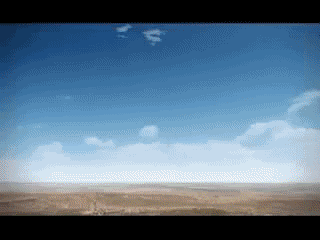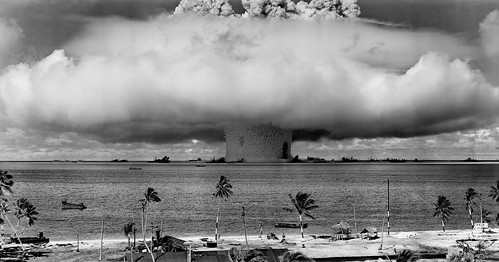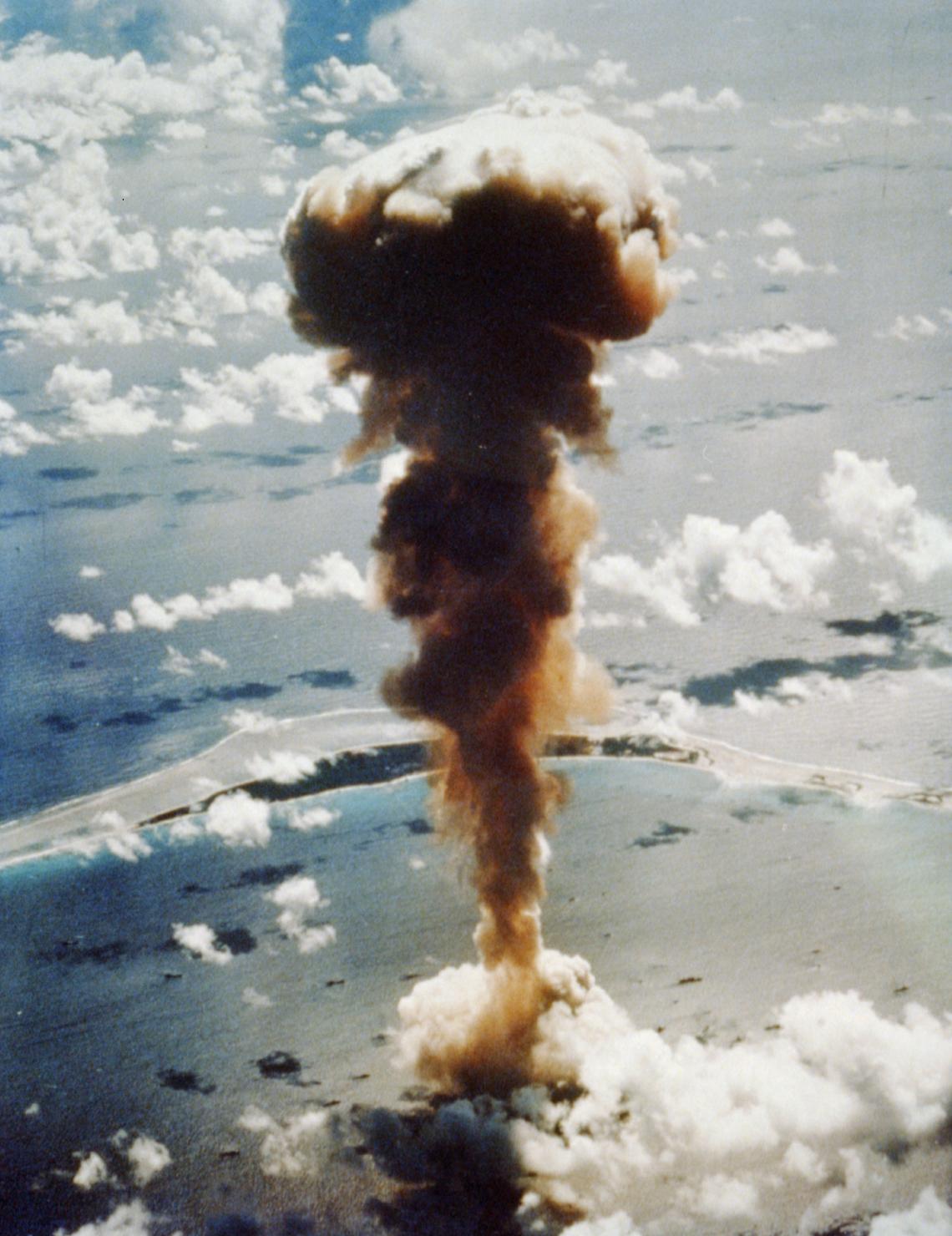
Posted on 07/26/2012 8:37:22 PM PDT by DogByte6RER
A Los Alamos Story Worthy of Stephen King
Ever heard of The Demon Core? It was named by Los Alamos scientists — who are generally not a superstitious lot — after it claimed multiple lives, in a series of strange and horrible accidents. Discover a legend of science... that's worthy of a horror movie.
When I was reading Stephen King stories, I was constantly amazed at the things he made scary. It was like reading the legend of the monkey's paw over and over again, with increasingly weird objects. His most famous evil objects are the hotel in The Shining and the car in Christine, but as he goes on, he manages to evil up a toy monkey, a painting, and a laundry press machine. When I read about The Demon Core, my thoughts automatically turned to King's work.
The Demon Core was a hunk of plutonium that was being used to refine the atomic bomb, just after it had been used in Japan. The plutonium in the core was P 239, a neutron-rich and unstable isotope. Neutrons were popping off it regularly. For the most part, they shot out of the core. Occasionally, they'd hit another atom and cause it to break down, giving off neutrons as well. As long as the rate of that reaction was low, it wasn't too dangerous to be around the core. The scientists at Los Alamos had to determine at what rate the reactions would get out of control. They did this by slowly stacking blocks of a substance that reflected neutrons around the core. The reflected neutrons would go back into the core and cause a higher reaction rate. As more and more of the core was surrounded, more neutrons bounced back. In turn, more reactions happened, and the scientists would monitor them with a Geiger counter.
One of the first reactions tests was conducted, unofficially and without other scientists present, by a gifted 24-year-old physicist named Harry Daghlian. He had built up walls around the core, monitoring it all the while, and then placed a brick on top of the walls. The reaction started cranking up to critical levels, and Daglian hurried to withdraw the brick. He dropped it on the core, causing it to be completely surrounded with the reflective substance. The radiation being given off skyrocketed, and Daghlian grabbed the brick. He dropped it again, right in the same spot. Unable to grab it again, he started taking apart the walls. By the time he had taken apart the structure, it was too late. He went into the hospital, and died of radiation poisoning about a month later.
Making a suitably large sphere of plutonium required the labor of entire industrial facilities. There was no known substitute for the material, and its top-secret nature made it tough to put in industrialized safety guards, especially for what was thought to be a freak accident. So a year later, Daghlian's friend, Louis Slotkin, was doing the same experiment, except with a different neutron reflector. He was experimenting with two half-bowls, and using a screwdriver to lever them more open and more closed, monitoring the radiation being released each way. He was supposed to be using safety wedges to keep the bowls slightly apart. For some reason, he didn't. They crashed together, and Slotkin, too, got a lethal dose of radiation.
After that, the core got a reputation, and acquired its name. It was eventually detonated in 1946, near the Bikini Islands. Several staff members, who were near the scene of one or other of the Los Alamos test accidents, died early of radiation-related diseases. Of course, there are always going to be accidents at any site. The fact that this kind of weaponry was new and the equipment was rough contributes. But when two friends both disregarded basic safety precautions, and were both claimed by the same core, it's not surprising that it gets a name. It's only surprising that it never got a short story.
FYI ... some more references:
The Curse of the Demon Core
http://www.neatorama.com/2011/11/28/the-curse-of-the-demon-core/
The Manhattan Project’s Fatal “Demon Core”
http://www.physicscentral.com/buzz/blog/index.cfm?postid=8146939447898984108
The Demon Core
http://talesfromthenuclearage.wordpress.com/2009/11/26/the-demon-core/
 Crossroads Able, a 23-kiloton air-deployed nuclear weapon detonated on July 1, 1946. This bomb used, and consumed, the infamous Demon core that took the lives of two scientists in two separate criticality accidents.
Crossroads Able, a 23-kiloton air-deployed nuclear weapon detonated on July 1, 1946. This bomb used, and consumed, the infamous Demon core that took the lives of two scientists in two separate criticality accidents.
I have to say that was a very interesting read.
Thanks for posting it ^^

www.orau.org/ptp/Library/accidents/la-13638.pdf is heavy but fascinating reading of all the criticality accidents all around the world, especially including the US and the Soviet Union, but also elsewhere. It’s dry and technical, but includes excerpts of interviews and (doomed) people’s notes aware of their own fate. It also includes reconstructions of what happened, in detail. Very technical, but fascinating to those inclined to such things. It’s also very long, to the tune of hundreds of pages.
Louis Slotin was one hell of a guy.
BFL
Sounds like suicide by hubris to me. There's nothing mysterious about disregarding basic safety precautions. I admit that radiation dangers probably weren't completely understood in those days but I'm sure both of those geniuses knew what had happened to Madame Curie.
From the Wikipedia:
On May 21, 1946, with seven colleagues watching, Slotin performed an experiment that involved the creation of one of the first steps of a fission reaction by placing two half-spheres of beryllium (a neutron reflector) around a plutonium core. The experiment used the same 6.2-kilogram (13.7 lb) plutonium core that had irradiated Harry K. Daghlian, Jr., later called the "Demon core" for its role in the two accidents. Slotin grasped the upper beryllium hemisphere with his left hand through a thumb hole at the top while he maintained the separation of the half-spheres using the blade of a screwdriver with his right hand, having removed the shims normally used. Using a screwdriver was not a normal part of the experimental protocol.
At 3:20 p.m., the screwdriver slipped and the upper beryllium hemisphere fell, causing a "prompt critical" reaction and a burst of hard radiation. At the time, the scientists in the room observed the blue glow of air ionization and felt a heat wave. In addition, Slotin experienced a sour taste in his mouth and an intense burning sensation in his left hand. Slotin instinctively jerked his left hand upward, lifting the upper beryllium hemisphere and dropping it to the floor, ending the reaction. However, he had already been exposed to a lethal dose of neutron radiation.
As soon as Slotin left the building, he vomited, a common reaction from exposure to extremely intense ionizing radiation. Slotin's colleagues rushed him to the hospital, but irreversible damage had already been done. His parents were informed of their son's inevitable death. A number of volunteers donated blood for transfusions, but the efforts proved futile. Slotin died nine days later on May 30, in the presence of his parents. He was buried in Winnipeg on June 2, 1946.
The core involved was subject to a number of experiments shortly after the end of the war and was used in the Able detonation, during the Crossroads series of nuclear weapon testing. Slotin's experiment was said to be the last conducted before the core's detonation and was intended to be the final demonstration of its ability to go critical.
The accident ended all hands-on critical assembly work at Los Alamos. Future criticality testing of fissile cores was done with special remotely controlled machines, such as the "Godiva" series, with the operator located a safe distance away to prevent harm in case of accidents.
Among the seven observers, two suffered from acute radiation syndrome but recovered. Years later, three of the observers eventually died of conditions that are known to be promoted by radiation, as did a security guard who was nearby during Daghlian's accident. Although some of those deaths were probably latent stochastic (random) effects of the accident, it is not possible to draw any definitive conclusions from such a small sample set.
bfl
Daghlian and Slotkin’s accidents were recreated in the film “Fatman and Little Boy.” Bad way to go.
I’ll just visualize pop rocks.
ping
I thought the tampers and neutron reflectors were part of the core assembly in the early bombs? Need to go read the "Making of the Atomic Bomb" again, though I just reread it a rew weeks ago.
Ping for later reading.
Richard Feynman called these experiments “tickling the tail of a sleeping dragon.”
Photo caption: At This Point, Our Picnic Ended
Criticality is dependent on mass, purity and density. You're thinking of a supercritical explosion. Criticality is simply a self-sustaining nuclear reaction. In a bomb, masses of radioactive material which would go critical if placed together, are split and kept apart. Then they are slammed together (very precisely) by explosives to shove them into a supercritical (explosive) state themselves. In a fission bomb, high explosives do the slamming (2 stages). In a fusion bomb, high explosives start a fission bomb, which then slams even higher potential nuclear fuel together into a fusion reaction (3 stages).
Disclaimer: Opinions posted on Free Republic are those of the individual posters and do not necessarily represent the opinion of Free Republic or its management. All materials posted herein are protected by copyright law and the exemption for fair use of copyrighted works.